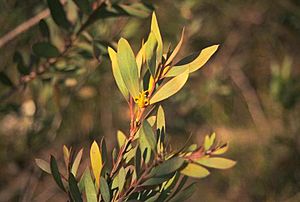Mittagong geebung facts for kids
Quick facts for kids Mittagong geebung |
|
|---|---|
 |
|
| Conservation status | |
| Scientific classification | |
| Genus: |
Persoonia
|
| Species: |
glaucescens
|
| Synonyms | |
|
|
The Persoonia glaucescens, also known as the Mittagong geebung, is a special flowering plant. It belongs to the Proteaceae family. This plant is endemic to New South Wales in Australia. This means it naturally grows only in that area.
The Mittagong geebung is an upright bush with smooth bark. Its young branches are a bit hairy. It has unique leaves shaped like a spear, with the narrower end near the stem. Its flowers are yellow. It's the only Persoonia plant in eastern Australia with leaves that have a strong, frosty blue-green color. This color is called glaucous.
Contents
What the Mittagong Geebung Looks Like
The Mittagong geebung is a bush that stands tall. It usually grows to be about 0.5 to 1.6 meters (about 1.5 to 5 feet) high. Sometimes, it can even reach 3 meters (nearly 10 feet) tall. It has smooth bark and reddish-brown branches. When the branches are young, they are covered with soft, greyish hairs.
Its leaves are shaped like a narrow spoon or a spear. The narrow part of the leaf is closer to the stem. These leaves have a cool, frosty blue-green color, especially when they are new. They are about 30 to 80 mm (1.2 to 3.1 inches) long and 4 to 18 mm (0.16 to 0.71 inches) wide. Each leaf twists a bit at its base.
The yellow flowers grow in groups of up to thirty. They are arranged along a stem called a rachis, which can be up to 190 mm (7.5 inches) long. Each flower sits on a short, hairy stalk called a pedicel, which is 1 to 3 mm long. The flower parts, called tepals, are yellow and about 11 to 12 mm (0.43 to 0.47 inches) long. They have a few hairs on the outside.
This plant blooms from January to May. After flowering, it grows a fleshy green fruit with purple spots. This fruit is called a drupe and holds one seed inside. The Mittagong geebung is special because it's the only type of Persoonia in eastern Australia with these distinct frosty blue-green leaves.
How it Got its Name
The Persoonia glaucescens was first officially described in 1827. This was done by a scientist named Kurt Polycarp Joachim Sprengel. He used notes from an earlier, unpublished description by Franz Sieber.
Later, in 1848, another scientist named Stephan Endlicher changed its classification. He made it a variety of another plant, calling it Persoonia lanceolata var. glaucescens.
For a while, scientists thought the Mittagong geebung grew in different areas than a similar plant, the P. lanceolata. However, a scientist named Peter H. Weston did more fieldwork. He found that these two plants sometimes grow together without mixing. Because of this, Weston brought back the original name, P. glaucescens. He published this change in a science journal called Telopea.
The Mittagong geebung belongs to a group of 58 closely related Persoonia species. They all have similar flowers but different leaves. These species can often interbreed (mix) if they grow near each other.
Where the Mittagong Geebung Lives
The Mittagong geebung grows in small, scattered areas. These areas are located between Buxton in the north and Berrima in the south of New South Wales. Sadly, it has disappeared from places like Thirlmere Lakes and Fitzroy Falls.
It prefers to grow on clay and gravel soils that are found on upper slopes and ridges. You can find it at altitudes between 400 and 650 meters (about 1,300 to 2,100 feet) above sea level.
This plant lives in dry sclerophyll eucalypt forests. It grows alongside trees like red bloodwood (Corymbia gummifera), scribbly gum (Eucalyptus sclerophylla), Sydney peppermint (E. piperita), silvertop ash (E. sieberi), narrow-leaved stringybark (E. sparsifolia), and grey gum (E. punctata). At higher elevations, it can also be found with snow gum (E. pauciflora). The Mittagong geebung also likes to grow on road verges. This is because there is more sunlight and fewer other plants competing for space there.
Protecting the Mittagong Geebung
The Persoonia glaucescens is considered "vulnerable" by the Australian Government. This means it is at risk of becoming endangered. The New South Wales Government lists it as "endangered."
The main things that threaten this plant are:
- Trail and road maintenance: Work on roads and trails can harm its habitat.
- Inappropriate fire regimes: Fires that happen too often, not often enough, or at the wrong time can hurt the plant.
- Grazing: Animals eating the plants can also be a problem.


